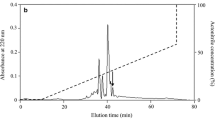Abstract
Cathelicidins comprise a family of antimicrobial peptides (AMPs) sharing a highly conserved cathelin domain, and play a central role in the innate defense against infection in most of vertebrates. But so far it has not yet been found in amphibians although a large number of other groups of AMPs have been identified. In the current work, the first amphibian cathelicidin (cathelicidin-AL) has been characterized from the frog skin of Amolops loloensis. Cathelicidin-AL (RRSRRGRGGGRRGGSGGRGGRGGGGRSGAGSSIAGVGSRGGGGGRHYA) is a cationic peptide containing 48 amino acid residues (aa) with 12 basic aa and no acidic aa. The chemical synthesized peptide efficiently killed bacteria and some fungal species including clinically isolated drug-resistance microorganisms. The cDNA encoding cathelicidin-AL precursor was cloned from the skin cDNA library of A. loloensis. As other cathelicidins, the precursor of cathelicidin-AL also contains highly conserved anionic cathelin domain of cysteine proteinase inhibitor followed by the AMP fragment at C-terminus. Phylogenetic analysis revealed that as connecting link, the amphibian cathelicidin predates reptilia but postdates fish cathelicidin. The peptide purification combined with gene cloning results confirms the presence of cathelicidin in amphibians and filled the evolutionary gap of cathelicidin in vertebrate, considering amphibians’ special niche as the animals bridging the evolutionary land-water gap.






Similar content being viewed by others
References
Bals R, Wilson J (2003) Cathelicidins-a family of multifunctional antimicrobial peptides. Cell Mol Life Sci 60(4):711–720
Bignami GS (1993) A rapid and sensitive hemolysis neutralization assay for palytoxin. Toxicon 31(6):817–820
Che Q, Zhou Y, Yang H, Li J, Xu X, Lai R (2008) A novel antimicrobial peptide from amphibian skin secretions of Odorrana grahami. Peptides 29(4):529–535
Feng F, Chen C, Zhu W, He W, Guang H, Li Z, Wang D, Liu J, Chen M, Wang Y (2011) Gene cloning, expression and characterization of avian cathelicidin orthologs, Cc©\CATHs, from Coturnix coturnix. FEBS J
Friedrich CL, Moyles D, Beveridge TJ, Hancock REW (2000) Antibacterial action of structurally diverse cationic peptides on gram-positive bacteria. Antimicrob Agents Chemother 44(8):2086
Gennaro R, Zanetti M (2000) Structural features and biological activities of the cathelicidin-derived antimicrobial peptides. Pept Sci 55(1):31–49
Lehrer RI, Ganz T (2002a) Cathelicidins: a family of endogenous antimicrobial peptides. Curr Opin Hematol 9(1):18
Lehrer RI, Ganz T (2002b) Defensins of vertebrate animals. Curr Opin Immunol 14(1):96–102
Li J, Zhang C, Xu X, Wang J, Yu H, Lai R, Gong W (2007) Trypsin inhibitory loop is an excellent lead structure to design serine protease inhibitors and antimicrobial peptides. The FASEB J 21(10):2466
Lu Z, Zhai L, Wang H, Che Q, Wang D, Feng F, Zhao Z, Yu H (2010) Novel families of antimicrobial peptides with multiple functions from skin of Xizang plateau frog, Nanorana parkeri. Biochimie 92(5):475–481
Mosmann T (1983) Rapid colorimetric assay for cellular growth and survival: application to proliferation and cytotoxicity assays. J Immunol Methods 65(1–2):55–63
Ramanathan B, Davis EG, Ross CR, Blecha F (2002) Cathelicidins: microbicidal activity, mechanisms of action, and roles in innate immunity. Microb Infect 4(3):361–372
Shinnar AE, Butler KL, Park HJ (2003) Cathelicidin family of antimicrobial peptides: proteolytic processing and protease resistance. Bioorg Chem 31(6):425–436
Turner J, Cho Y, Dinh NN, Waring AJ, Lehrer RI (1998) Activities of LL-37, a cathelin-associated antimicrobial peptide of human neutrophils. Antimicrob Agents Chemother 42(9):2206
Valenzuela JG, Charlab R, Mather TN, Ribeiro J (2000) Purification, cloning, and expression of a novel salivary anticomplement protein from the tick, Ixodes scapularis. J Biol Chem 275(25):18717
Wang Y, Hong J, Liu X, Yang H, Liu R, Wu J, Wang A, Lin D, Lai R (2008) Snake cathelicidin from Bungarus fasciatus is a potent peptide antibiotics. PLoS One 3(9):e3217
Wang Y, Lu Z, Feng F, Zhu W, Guang H, Liu J, He W, Chi L, Yu H (2010) Molecular cloning and characterization of novel cathelicidin-derived myeloid antimicrobial peptide from Phasianus colchicus. Dev Comp Immunol 35(3):314–322
Xiao Y, Cai Y, Bommineni YR, Fernando SC, Prakash O, Gilliland SE, Zhang G (2006) Identification and functional characterization of three chicken cathelicidins with potent antimicrobial activity. J Biol Chem 281(5):2858
Zaiou M, Gallo RL (2002) Cathelicidins, essential gene-encoded mammalian antibiotics. J Mol Med 80(9):549–561
Zanetti M (2004) Cathelicidins, multifunctional peptides of the innate immunity. J Leukoc Biol 75(1):39
Zanetti M (2005) The role of cathelicidins in the innate host defenses of mammals. Curr Issues Mol Biol 7(2):179–196
Zanetti M, Gennaro R, Romeo D (1995) Cathelicidins: a novel protein family with a common proregion and a variable C-terminal antimicrobial domain. FEBS Lett 374(1):1–5
Zanetti M, Gennaro R, Scocchi M, Skerlavaj B (2002) Structure and biology of cathelicidins. The Biology and Pathology of Innate Immunity Mechanisms 203–218
Acknowledgments
This work was funded by the grants from Chinese National Natural Science Foundation (30900240, 41076098).
Conflict of interest
The authors declare that they have no conflict of interest.
Author information
Authors and Affiliations
Corresponding authors
Additional information
X. Hao, H. Yang, and L. Wei have the same contribution to this paper.
Electronic supplementary material
Below is the link to the electronic supplementary material.
Fig. S1. Matrix-Assisted Laser Desorption Ionization Time-Of-Flight mass spectrometer (MALDI-TOF–MS) analysis of the RP-HPLC peak containing antimicrobial activity.

Rights and permissions
About this article
Cite this article
Hao, X., Yang, H., Wei, L. et al. Amphibian cathelicidin fills the evolutionary gap of cathelicidin in vertebrate. Amino Acids 43, 677–685 (2012). https://doi.org/10.1007/s00726-011-1116-7
Received:
Accepted:
Published:
Issue Date:
DOI: https://doi.org/10.1007/s00726-011-1116-7




